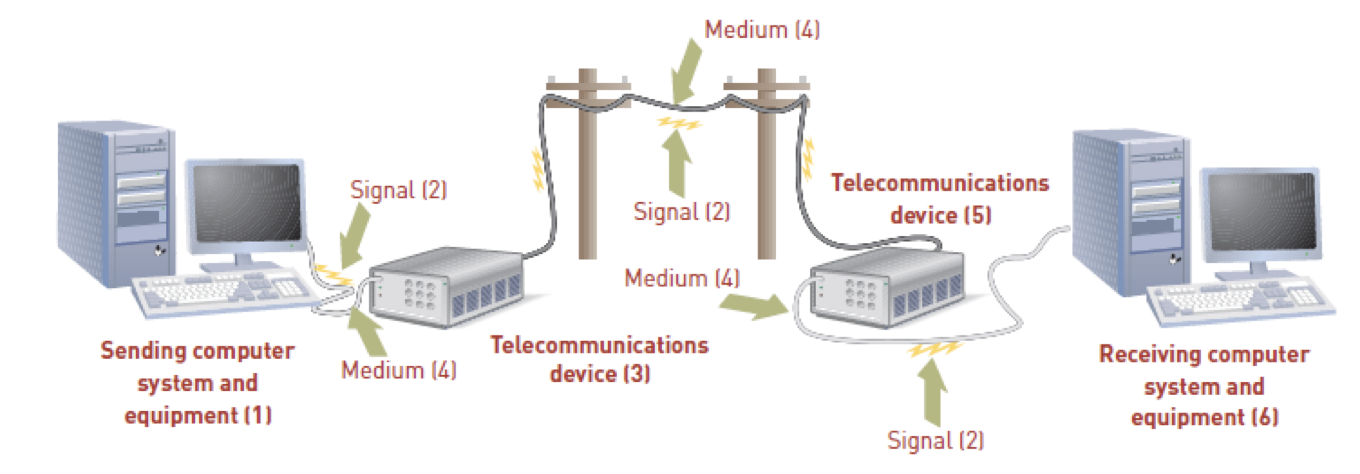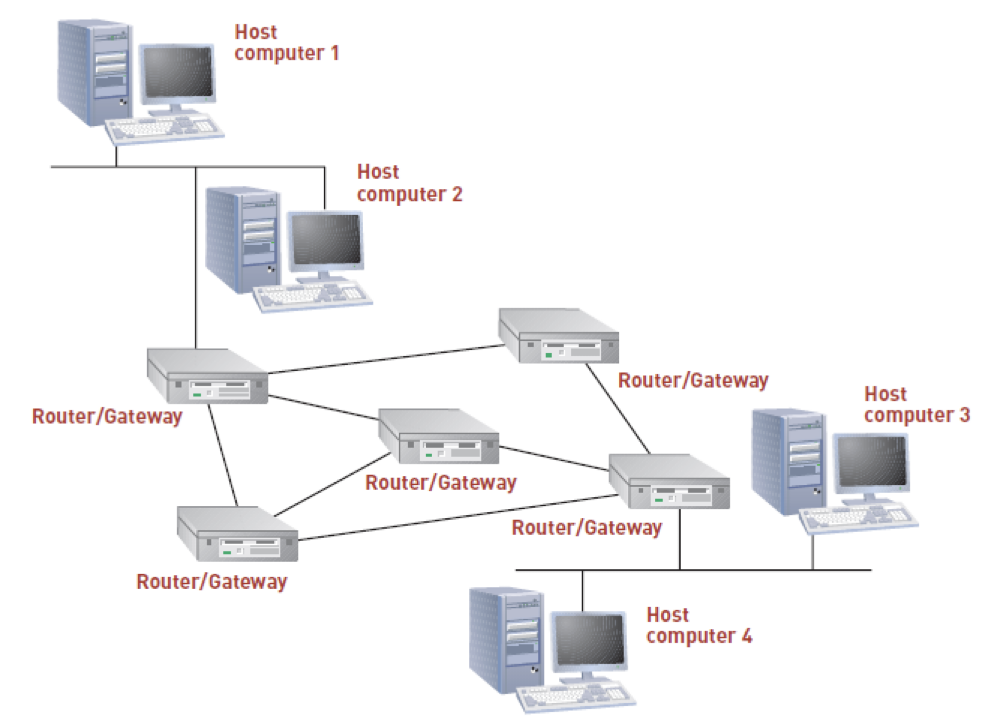Ch 4. Telecommunications, the Internet, Intranets, and Extranets
Supply chain management might use telecommunications and networks the most among all business functions
- Telecommunications are electronic transmission of signals for communications
- telecommunications medium: any material substance that carries an electronic signal to support communications between a sending and receiving device
- Telecommunications devices relay signals between computer systems and transmission media
Channel Bandwidth: is the rate at which data is exchanged.
Broadband communications are telecommunication systems that can exchange data very quickly
Communications Media: are the means of delivering and receiving data or information
Guided transmission media types include:
- Wireless technologies
- Microwave transmission
- 3G/4G wireless communications
- Worldwide interoperability for microwave access (WiMAX)

Wireless technologies: Wireless telecommunications involves the broadcast of communications in one of three frequency ranges → microwave, radio, and infrared
Microwave transmission: high frequency (300MHz-300GHz) signal sent through the air
3G wireless communications: supports wireless voice broadband speed data communications in a mobile environment
4G wireless communications: 4G will also provide increased data transmission rates in the 20-40 Mbps range
- Worldwide interoperability for microwave access (WiMAX)
- Operated like wifi, only over greater distances and at faster transmission speeds
Telecommunications Hardware: Smartphones:
- Have their own software operating systems
- Applications are developed by: manufacturers, operators of the communications network on which they operate, third-party software developers
- Modem, Fax modem, Multiplexer, PBX, Front-end processor, Switch, Bridge, Router
Networks and Distributed Processing
- Computer network: consists of communications media, devices, and software needed to connect two or more computer systems or devices
- Can transmit and receive information to improve organisation effectiveness and efficiency
Network types:
- Personal area networks (PAN): support interconnection of information technology within a range of about 33 feet
- Local area network (LAN): connect computer systems and devices within a small area (office/home)
- Metropolitan area networks (MAN): connect users and their devices in a geographical area that spans a campus or city
- Wide area networks (WAN): connect large geographic regions
- In a typical LAN, all network users within an office can connect to each other's devices for rapid communication.
- Distributed Processing:
- Centralised processing: all processing occurs in a single location or facility
- Decentralised processing: processing devices are places at various remote locations
- Distributed processing: processing devices are placed at remote locations but are connected to each other via a network
- Client/server systems:
- Client/server Architecture: multiple computer programs are dedicated to special functions
- Server: distributes programs and data to other computer (clients) on the network as they request them
Telecommunications software
- Network Operating system (NOS): systems software that controls the computer systems and devices on a network
- Network management software: protects software from being copied, modified, or downloaded illegally
- Located telecommunications errors and potential network problems
Use of the Internet/How it works:
- ARPANET: ancestor of the internet
- Internet Protocol (IP): enables computers to route communications traffic from one network to another
- IP Protocol: set of rules to pass packets from one host to another
- IP Address: 64-bit number that identifies a computer on the internet
- Uniform Resource Locator (URL): web address that specific the exact location of a web page
- Internet Corporation for Assigned Names and Numbers (ICANN):
- Responsible for managing IP addresses and the internet domain names
- Has authority to resolve domain name disputes
Domain Name ID: The internet routes data packets over the network backbone from route to route to reach their destinations
- Com → business sites
- Gov → government sites
- Net → networking sites
- Edu → educational sites
- Org → non-profit organisation sites
- Mobi → mobile-compatible sites for smartphones

Accessing the Internet: access method determined by the size and capability of your organisation or system
- Connect via LAN server: business LAN servers are typically connected to their internet at very fast data rates
- Connecting via internet service providers: an ISP is any organisation that provides internet access to people
Cloud Computing: Computer environment in which software and storage are provided as an internet service and accessed with a web browser
- Extremely scalable and often takes advantage of virtualisation technologies
Advantages to businesses:
- Businesses can save on system design, installation, and maintenance
- Employees can access corporate systems from any internet-connected computer
World Wide Web & How it Works: Originally created as an internal document management system, and has become:
- Primary source of information and news
- Indispensable conduit for commerce
- A popular hub for social interaction, entertainment, and communication
The Internet: made up of computers, network hardware such as routers and fiber-optic cables, software, and the TCP/IP protocol
The Web: consists of server and client software, the hypertext transfer protocol (http), and mark-up languages that combine to deliver information and services over the internet
It works using:
- Hyperlink: highlighted text or graphics in a web document that, when clicked, opens a new web page
- Web browser: web client software such as internet explorer, firefox, and safari used to view web pages
- Hypertext markup language (HTML): standard page description language for web pages
- HTML tags: tell the web browser how to format text
- Extensible markup language (XML): markup language for web documents containing structured information
- Cascading style sheet (CSS): markup language that defines the visual appearance of content in a web page
Web Programming Languages:
- Java:
- Object oriented programming language from sun microsystems based on C++
- Allows small programs (applets) to be embedded within an HTML document
- Other documents: JavaScript, VBScript, ActiveX
- Hypertext Preprocessor (PHP)
Web services: Standards and tools that streamline and simplify communication among web sites
- XML: the key to web services
Developing Web Content:
- Web publishing tools: .NET, Bubbler, Homestead QuickSites, and JobSpot
- Mashup: named for the process of mixing two or more hip-hop sings into one song
Popular uses for the Internet and Web:
- Publishing information
- Assisting users in finding information
- Supporting communication and collaboration
- Building online community
- Providing software applications
- Providing a platform for expressing ideas
- Delivering media of all types
- Providing a platform for commerce
- Supporting travel and navigation \n
Online Information Sources:
- Business information: businesses often use internet and web-based systems for knowledge management
- Search Engines: enable you to find information on the web by specifying keywords (example: google)
Rich Internet Applications: software that has the functionality and complexity of traditional application software but does not require local installation and runs in a web browser
- Result of continuously improving programming languages and platforms designed for the web
Intranet: internal corporate network built using internet and world wide web standards and technologies
Extranet: network that links selected resources of a company’s intranet with its customers, suppliers, or other business partners